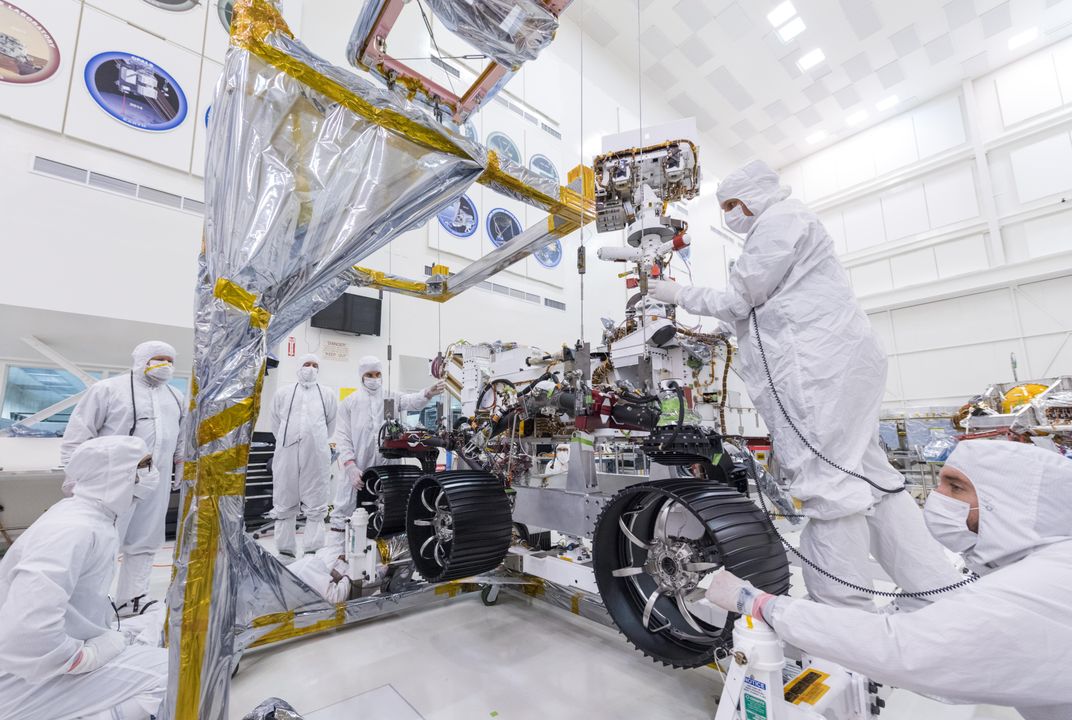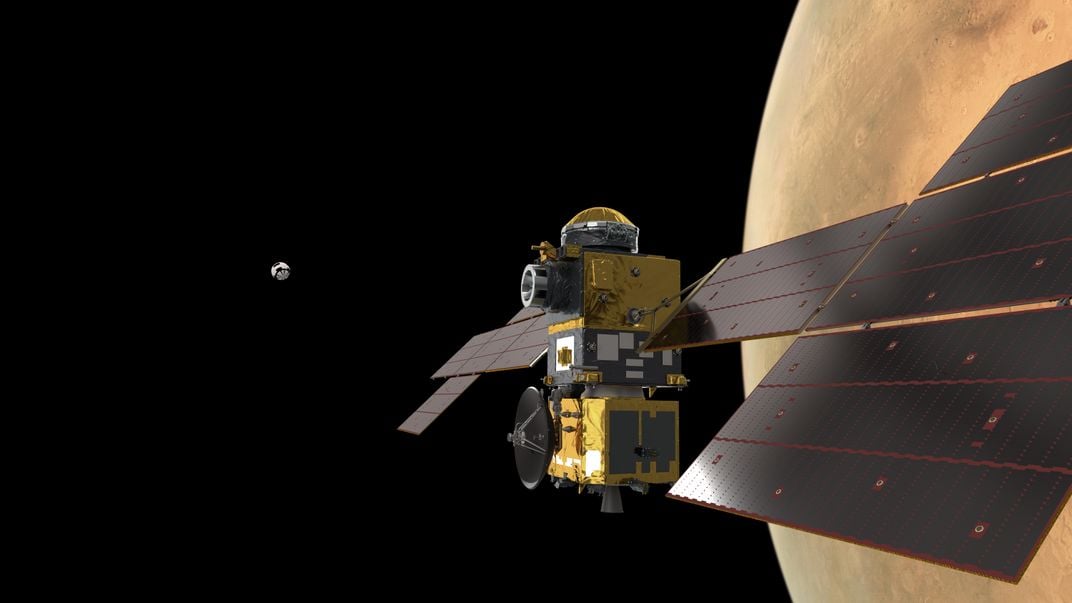If It Works, This Will Be the First Rocket Launched From Mars
NASA has spent decades sending probes to other planets. Now it’s trying to go the other way.
:focal(571x685:572x686)/https://tf-cmsv2-smithsonianmag-media.s3.amazonaws.com/filer/d6/4a/d64a80d9-b93f-4fb6-813f-cf6d0319b6d5/14b_on2019_marssamplereturnfinalsize_live.jpg)
About a dozen years from now, Martians might finally arrive on Earth. If they do, it will be because we brought them here.
NASA and the European Space Agency are planning an audacious mission to gather samples of rock and soil from the surface of the red planet and transport them across 34 million miles of space—giving scientists an unprecedented opportunity to study what Mars is made of and to search for evidence that the planet once harbored life. Because past missions have revealed signs of Martian lakes and river deltas, the scientists believe they may find the fossils of microscopic organisms that thrived in those lakes and rivers before the planet became the frigid desert that it is today.
Next July, the three-part mission to return samples from Mars will begin with the launch of the Mars 2020 rover. While the rover is exploring and collecting soil, NASA engineers will continue developing the technology for the other two phases of the mission—launching a rocket lifting the samples to Martian orbit, where it will rendezvous with a waiting return vehicle that will ferry the precious cargo to Earth. For each of the steps in that process, the engineers at NASA’s Jet Propulsion Laboratory are confronting a series of daunting challenges.
For starters, nobody has ever launched a rocket from the surface of another planet. This is a very different scenario from the one that brought Apollo astronauts home from the moon, just 238,900 miles away. Unlike the ascent stage of the Apollo Lunar Module, the planned Mars Ascent Vehicle (MAV) will have to free itself from a planet’s gravity, even if the pull is only 38 percent of the surface gravity of Earth. And before the ascent vehicle launches for home, it will have had to endure a gauntlet of physical punishments.
First, as a payload aboard a lander headed to Mars, the MAV will be subjected to the rough ride of a launch from Earth, followed by a six- to nine-month flight through deep space, which will culminate in a fiery entry into the atmosphere surrounding Mars, a supersonic descent, and a not-so-soft landing. After that, the craft will sit on the surface for half a Mars year (equal to a full year on Earth), exposed to dust storms, ultraviolet radiation, and temperatures as low as minus 40 degrees Fahrenheit.
Another crucial difference from the Apollo missions: There will be no humans on the spacecraft. And because it can take several minutes for a transmission to reach Mars, even remote piloting is out of the question.
“We can’t joystick it,” says Paulo Younse, an engineer at NASA’s Jet Propulsion Laboratory. “We can’t communicate with it, and we don’t have a person on board, so it’s got to be automatic.”

On February 18, 2021, the Mars 2020 rover will touch down in the 30-mile-wide Jezero Crater (pronounced “YEH-zuh-roh”), where it will collect samples and cache them in hermetically sealed tubes for later retrieval. NASA spent five years deliberating over a landing site before it settled on Jezero. Scientists believe that between 4.1 and 3.5 billion years ago the crater was filled with a lake, 820 feet deep. Perhaps more exciting are the signs of a river delta. A delta is “extremely good at preserving biosignatures, evidence of life that might have existed in the lake water, or at the interface between the sediment and the lake water, or, possibly, things that lived in the headwaters region that were swept in by the river and deposited in the delta,” said Mars 2020 project scientist Ken Farley when announcing the landing site last November.
The rover will collect samples from at least five different kinds of rock, including clays and carbonates, which have high potential to preserve indicators of ancient life, whether in the form of complex organic molecules or the fossils of microbes. The search for samples will be aided by a suite of instruments, including SHERLOC (Scanning Habitable Environments with Raman and Luminescence for Organics and Chemicals), which uses spectrometers, an ultraviolet laser, and a camera to detect organic compounds. But, scientists say, this equipment will be no substitute for the more sophisticated instruments on Earth—especially when confronted with the challenging task of distinguishing signs of life from chemical activity that might mimic organic processes.
“To really make the next big leap in understanding Mars as a system, we want to have samples here,” says Charles Edwards, a JPL manager for the Mars Exploration Directorate. “By getting those samples back to Earth, you can really unleash the power of all the terrestrial laboratories and answer some of the questions that we want to answer about life on Mars—whether we’re talking about extinct life or even extant life.”
NASA and the European Space Agency have joined forces to plan for the later missions—not yet scheduled—that eventually will complete Mars Sample Return. After Mars 2020, the next step is to send another lander to Jezero Crater carrying a “fetch rover” and the Mars Ascent Vehicle. The rover will fetch the tubes containing the samples of rock and soil cached by Mars 2020, then load them into the MAV’s payload container, a 17-pound cylinder about the size of a volleyball. The MAV will then be raised, likely autonomously, from a horizontal to an upright launch position and will lift off to rendezvous with the third part of the mission: an Earth Return Orbiter.
The demands being placed on the design for the MAV make it the riskiest part of the mission. Ashley Karp, propulsion lead and deputy manager for the ascent vehicle at JPL, says developing the propulsion system for the rocket is the toughest engineering challenge she has worked on during her seven years at the NASA facility. “We need to fit within the entry, descent, and landing system to get us to Mars, and then to be able to launch, and deliver the samples to another system as well,” Karp says. “So there are multiple interfaces at play.”
The propulsion system will require fuel that can withstand the temperature extremes of Mars while also meeting the volume and weight requirements that will allow the MAV to fit inside a Mars lander: It can be no heavier than about 880 pounds and no taller than around 10 feet. Over the last two decades, NASA engineers have toyed with multiple MAV propulsion designs and have now zeroed in on two possibilities: a single-stage hybrid rocket motor and a two-stage solid-fuel rocket motor.
The key advantage of solid-fuel rockets is that the technology is well-understood, Karp says. In fact, they’ve already been used on previous missions—such as Pathfinder, Spirit, and Opportunity—to land on Mars. Solid-fuel motors are less complex than motors using liquid fuels, which require a feed system as well as either a pressurization system or pumps. And since solid propellant is less corrosive and more stable than liquid fuel, it can be easily stored for long periods.
Hybrid rockets—which store the oxidizer as a liquid or gas, and the fuel as a solid—are a tougher problem to solve. Engineers have been tinkering with designs ever since 1933, when the Soviet Union launched a rocket that combined liquid oxygen and a solid form of gasoline. But unlike solid rockets, where the oxidizer and fuel are already combined into a single propellant, it’s hard to safely achieve a high thrust with hybrid rockets, because the solid-fuel component doesn’t burn quickly enough when the liquid oxidizer is sprayed on separately during flight. And yet, despite being the lesser-developed technology, NASA believes the potential advantages of a hybrid rocket for a Mars mission are too numerous to ignore. Once a solid-fuel rocket is ignited, it has to stay lit. A hybrid offers more options for maneuvers since it can be throttled, shut down, and reignited in flight.
NASA is optimistic about a hybrid because of a new fuel with a higher burn rate. It’s a paraffin called SP7, a waxy solid made from a mixture of saturated hydrocarbons. The oxidizer is called MON25—a liquid oxidizer that contains 25 percent mixed oxides of nitrogen.
The problem with a conventional solid propellant is that the extreme temperatures on Mars could cause it to crack and possibly explode upon ignition. As such, if NASA opted for a solid-fuel rocket motor, the lander would need to devote crucial power to keeping the MAV warm. By contrast, the waxy SP7 used in a hybrid rocket motor can remain structurally sound when exposed to wide variations in temperature and the oxidizer MON25 has a freezing point of minus 67 degrees Fahrenheit, which also offers plenty of margin for the range of temperatures expected at Jezero Crater between the time the MAV lands on Mars and lifts off a full Earth-year later.
In late April, the hybrid rocket passed a crucial threshold: a successful ignition at minus four degrees Fahrenheit. “It was the first demonstration that it actually worked,” says Karp. In late July, two more tests were conducted. The first tested the rocket’s rapid ignition system for a second burn as well as a new rocket nozzle, and the second tested a tweaked SP7 formulation.

Whichever MAV design is chosen, it will require autonomous guidance, navigation, and control technologies to achieve the proper Mars orbit so the Earth Return Orbiter can find it. For Evan Anzalone, a guidance and navigation engineer at the Marshall Space Flight Center, the toughest challenge would be to establish initial conditions before launch—exactly where on the surface the MAV is in relation to its target orbit, and exactly which way it is pointing (its attitude). The rocket’s attitude is determined not only by the direction its nose cone is pointed but also by the planet’s rate of rotation and local gravity environment.
“The better we can measure those things, the better we can figure out what our initial attitude is,” says Anzalone. “The problem can be solved, and we’ve done it with big vehicles. But when you get down to this smaller size, having to do all this autonomously, with a long delay for any kind of commands and checkouts….”
Anzalone and his colleagues are studying two approaches to guidance, control, and navigation. One is called “open loop” guidance, in which the rocket is essentially preprogrammed to fly a certain trajectory. “You just give commands to your actuators and go,” Anzalone says. It’s a relatively simple way to launch a rocket, but it carries risks. If, for example, the Mars lander carrying the MAV lands at Jezero Crater so that the rocket’s attitude is just one degree off, an open loop guidance system would launch with that initial error and the MAV wouldn’t reach its target orbit.
By contrast, the other option is “closed loop” guidance, a much more complicated system. With this approach, the rocket monitors its position, thrust, and velocity during flight and adjusts where it’s pointing its nozzle to tweak its trajectory.
Once the MAV reaches its designated orbit, it should release the capsule containing the samples.The Earth Return Orbiter, aligned in the same orbit, would creep up on it at a closing rate of about two inches per second. It’s likely the sample container would be light in color, possibly with symbols resembling QR codes, says Paulo Younse, the JPL engineer developing the capture and containment system. These features would allow cameras on board the orbiter to more easily find its target. Up until a separation of about 328 feet, flight controllers would be able to monitor the approach and possibly make course corrections before the rendezvous. After that, however, “it’s all on board [and] the spacecraft will fly itself,” says Jeffrey Umland, chief mechanical engineer for NASA’s current InSight mission to Mars and a collaborator on the capture and containment system.
“We have this very precious thing, and it’s got some inertia to it,” Younse says. “It’s moving and it’s spinning at a slow rate, and the challenge is to now capture this thing, robotically, on orbit, and bring it into our system, package it into a container so we can seal it up and bring it back to Earth. We haven’t ever done anything that complicated.”
While the European Space Agency is developing the Earth Return Orbiter, engineers at JPL are designing the capture-and-containment system on board that spacecraft.
At the front of that system would be a capture cone, with a suite of sensors that would detect when the container is fully inside—at which point a lid would quickly (within two seconds) shut over the top of the cone before the container has a chance to hit the back of the cone and bounce back out into space. “Think of it more or less as a mouse trap, but we fly to the mouse,” says Umland.
Inside the cone, a mechanical arm affixed to a paddle would then swing over the container and push it down toward the back of the capture cone and into a containment vessel. Another device, possibly a kind of wiper mechanism, would sweep over the container to orient it so that the sample tubes are stored right side up relative to the heat shield of the spacecraft. Mission planners believe the hermetic seals on the tubes would have the best chance of surviving if they faced away from the direction of travel during reentry and arrival on Earth—possibly at a landing range in the Utah desert.
It’s not the way that science-fiction authors have traditionally imagined Martians arriving on Earth. But, if it succeeds, we might finally obtain evidence of life on another world.
/https://tf-cmsv2-smithsonianmag-media.s3.amazonaws.com/accounts/headshot/Bruce_Lieberman_Yosemite_Cropped.jpg.jpeg)

/https://tf-cmsv2-smithsonianmag-media.s3.amazonaws.com/accounts/headshot/Bruce_Lieberman_Yosemite_Cropped.jpg.jpeg)